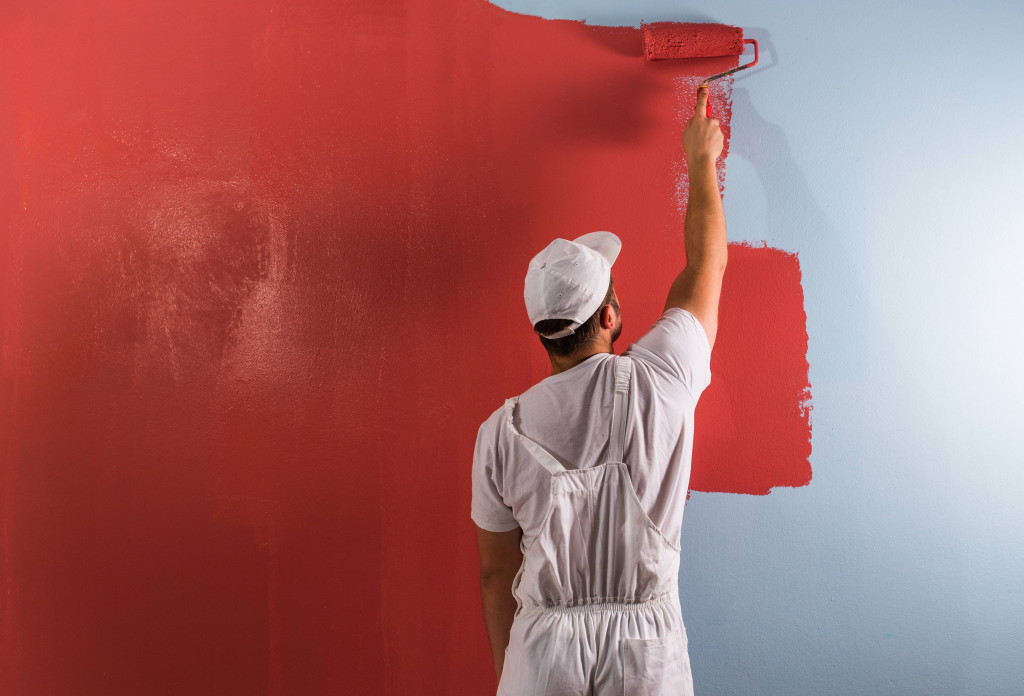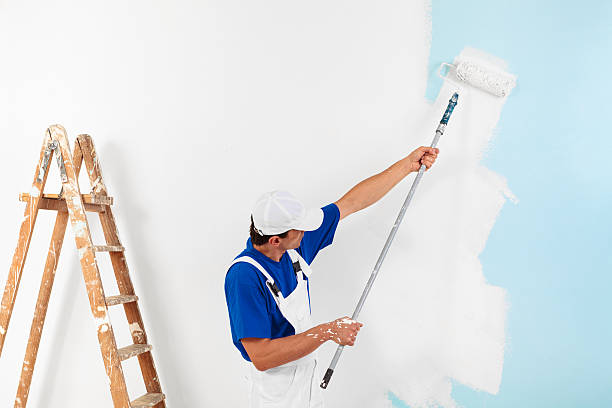Stay Ahead With New Paint Trends: Mixing Techniques for Modern Interiors

The Surge of Shade Gradients in Interior Decoration
As designers increasingly look for ingenious means to improve areas, the rise of color gradients in interior layout has actually gathered significant focus. This strategy, identified by the smooth shift between 2 or more shades, permits a vibrant aesthetic effect that can change a regular room right into a vivid setting. Color slopes can evoke feelings, affect understandings of room, and create focal factors, making them a functional option for different layout styles.
The application of gradients prolongs beyond wall surfaces; they can be effectively used in furniture, fabrics, and accessories. Designers frequently explore varying tones to attain deepness and intrigue, interesting a variety of aesthetic appeals from minimal to diverse. In enhancement, the adaptability of slopes allows their use in both industrial and domestic settings, satisfying varied clients. As fads progress, the use of color slopes symbolizes a change in the direction of even more expressive and personalized indoor areas, mirroring specific preferences and way of lives.
Embracing Ombre Strategies for a Dynamic Look
Ombre strategies have actually become a charming choice for those wanting to include deepness and activity to modern-day interiors. This gradient result shifts smoothly from one color to an additional, producing a visually striking focal point in any type of room. Developers value ombre for its flexibility; it can be related to wall surfaces, furniture, or also attractive accents, enabling unique expressions of design.
The technique works specifically well with soft tones, giving a tranquil atmosphere, while vibrant colors can energize a room. House owners can trying out different color schemes, selecting different shades for a remarkable impact or unified tones for a refined impact. The application of ombre is not limited to a solitary wall; it can prolong throughout a room, improving the perception of room and light.
As a modern pattern, ombre techniques satisfy diverse tastes, permitting people to personalize their insides and welcome imagination in their layout method. benjamin moore paint store corpus christi.
Textured Walls: Layering Paint for Depth and Interest
Textured walls can substantially improve the aesthetic allure of modern interiors by including deepness and passion. Strategies for developing appearance, thoughtful color mixes, and the right tools for layering are essential parts in achieving this result. Discovering these elements allows for a individualized and vibrant approach to interior decoration.
Techniques for Texture Creation
Creating visual passion in interior spaces commonly rests on the artful application of structure. Different methods can be employed to achieve this, such as sponging, rag rolling, and stippling. Sponging involves making use of a wet sponge to use a 2nd shade over a skim coat, developing a soft, varicolored result. Rag rolling, on the other hand, uses a rolled rag to apply paint, leading to a much more dynamic texture. Stippling uses a tight brush or tool to dab paint onto the surface area, developing an one-of-a-kind pattern. In addition, layering different finishes, such as matte and shiny, can improve depth. These techniques not only offer visual charm but also add to the total setting of modern interiors, urging a tactile experience.
Color Combinations for Effect
Layering paint not only boosts structure however also opens a world of color mixes that can significantly affect the state of mind of an area. By mixing corresponding shades, developers can develop a harmonious result that welcomes warmth or coolness, relying on the wanted ambience. For instance, abundant earth tones combined with soft pastels can evoke a serene setting, while vibrant, different colors can add vibrancy and power. Furthermore, including metal or shiny finishes within the layers can present a dynamic visual element, capturing light and enhancing the depth of the shade scheme. Inevitably, thoughtful color combinations via layering paint supply an opportunity to reveal specific design while changing common wall surfaces right into captivating prime focus.
Devices for Layering Effect
Numerous devices are vital for attaining a successful layering result in paint applications, which can transform walls right into enchanting visual experiences. Brushes and rollers are fundamental, with different dimensions permitting different textures and surfaces. Specialty devices like dustcloths and sponges can produce distinct patterns and deepness, while combination blades use precision for more specified lines. For larger locations, making use of a stippling brush can include an intricate finish. Furthermore, spray weapons can successfully use numerous layers for a smooth, also layer. Painters should likewise take into consideration painter's tape to develop tidy edges in between layers. By making use of the right devices, one can efficiently improve the visual charm of insides, making each wall surface an interesting prime focus.

The Power of Color Obstructing in Modern Spaces
As contemporary interior decoration remains to develop, shade obstructing emerges as an effective technique that can transform areas with vibrant visual influence. This approach involves the calculated placement of contrasting colors to produce specified zones within an area, enhancing both the aesthetic charm and functionality of the space. corpus christi paint store. By utilizing large swathes of color, designers can assist the eye and emphasize architectural aspects, leading to a dynamic environment
Shade barring is not restricted to walls; it can likewise be put on furnishings and decor, enabling limitless customization. Coupling a dynamic shade with a neutral tone can create a striking focal point while keeping balance. This method urges imagination, making it possible for home owners to express their personalities with distinct shade mixes. Ultimately, shade obstructing offers as an effective means to revive modern-day insides, making spaces really feel fresh, energetic, and aesthetically interesting.
Incorporating Metallics for a Glamorous End up
Exactly how can metallics raise the elegance of contemporary interiors? Metal coatings function as a striking focal point, adding depth and visual passion to rooms. They can change a standard room right into a classy resort via the subtle interplay of light and reflection. Designers often advise incorporating metallics in accent wall surfaces, ceilings, or furniture to produce an elegant ambience without frustrating the space.
Different metal shades-- such as bronze, silver, and gold-- offer adaptability, enabling homeowners to customize their aesthetic. A soft gold can pass on heat, while a streamlined silver can offer a contemporary touch. When coupled with neutral tones, metallics enhance the total design, supplying an innovative contrast that draws the eye.
Incorporating metallic paint into trim or moldings website can likewise boost building details, producing a sleek surface. Ultimately, the tactical use of metallics can instill contemporary interiors with prestige and improvement, making them genuinely charming.
Imaginative Use Stencils for Special Patterns
Changing walls with patterns can infuse contemporary interiors with distinct personality and design. This creative strategy permits designers and homeowners to create personalized patterns that show personal appearances. Patterns can vary from elaborate geometric designs to wayward motifs, enabling a large range of expressions. By picking contrasting colors, patterns can elevate an area's visual charm and function as prime focus without overwhelming the area.
Stencils are functional; they can be used to different surface areas, including wall surfaces, furnishings, and even ceilings. This versatility makes stenciling an excellent option for do it yourself enthusiasts looking to boost their home affordably. Furthermore, the convenience of application and elimination allows for experimentation, making it possible for people to refresh their design with minimal initiative. Ultimately, creative use patterns not just transforms common surface areas however also provides an opportunity for self-expression, making them a trending selection in modern-day interior decoration.
Blending Matte and Glossy Finishes for Comparison
The interplay of matte and shiny coatings can produce a striking aesthetic dynamic in contemporary insides. Developers typically use this contrast to enhance architectural features and specify spaces. Matte surfaces, with their soft, non-reflective top quality, can produce a sense of warmth and intimacy, making them suitable for wall surfaces and larger surfaces. In contrast, shiny coatings reflect light, adding vibrancy and depth, making them ideal for accents such as trim, moldings, or furniture.
The combination of these textures can direct the eye and stress prime focus within a room. Matching a matte-painted wall surface with shiny cabinets can develop an innovative equilibrium. Furthermore, the mindful application of both surfaces can stimulate different moods while enhancing the overall aesthetic. As home owners increasingly look for individualized spaces, blending matte and shiny surfaces provides a functional technique to attaining modern style and visual passion in indoor layout.
Frequently Asked Concerns
What Equipment Are Best for Mixing Paint Strategies?
A selection of tools are perfect for mixing paint strategies, consisting of foam rollers, brushes with soft bristles, sponge applicators, and airbrushes. Each tool provides distinct impacts, boosting the mixing process for numerous creative applications.
Just How Can I Take Care Of Blending Mistakes?
To deal with blending blunders, one should gently sand the damaged area, apply a primer if necessary, and after that very carefully reapply paint making use of a soft brush or sponge to attain a smooth shift and recover the preferred impact.
Are There Details Paint Brands Recommended for Mixing?
Numerous paint brand names are advised for mixing, including Benjamin Moore, Sherwin-Williams, and Behr. These brand names supply top quality coatings and a wide variety of shades that facilitate smooth shifts and effective mixing techniques in different interior projects.
Can I Mix Paint Without Professional Aid?
Yes, blending paint without professional help is possible. With technique and the right tools, individuals can attain desirable effects. Different online tutorials and guides can aid in grasping mixing strategies for individual projects.

How Long Does Blended Paint Last on Wall Surfaces?
Combined paint can last anywhere from five to 10 years on walls, relying on elements such as the quality of paint used, surface preparation, and environmental conditions. Routine maintenance typically improves long life and look.
As developers significantly look for ingenious ways to improve spaces, the increase of color gradients in indoor layout has actually garnered significant attention. The technique works particularly well with soft hues, offering a tranquil atmosphere, while bold colors can energize a space. Strategies for developing structure, thoughtful shade mixes, and the right tools for layering are necessary parts in attaining this result. Layering paint not only enhances appearance but also opens up a globe of color mixes that can considerably influence the state of mind of a space. As modern-day interior layout continues to progress, color blocking emerges as a powerful method that can change rooms with strong aesthetic influence.